| Reviews & Columns |
|
Reviews DVD TV on DVD Blu-ray 4K UHD International DVDs In Theaters Reviews by Studio Video Games Features Collector Series DVDs Easter Egg Database Interviews DVD Talk Radio Feature Articles Columns Anime Talk DVD Savant Horror DVDs The M.O.D. Squad Art House HD Talk Silent DVD
|
DVD Talk Forum |
|
|
| Resources |
|
DVD Price Search Customer Service #'s RCE Info Links |
|
Columns
|
|
|
Buffy the Vampire Slayer - The Complete Sixth Season
Fox // Unrated // May 25, 2004
List Price: $59.98 [Buy now and save at Amazon]
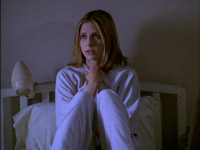 Buffy the Vampire Slayer's sixth season polarized longtime fans of the show, inspiring lengthy tirades on innumerable message boards about how this was either the worst season of the series' run or its best. When these episodes originally debuted, I was squarely in the "worst" camp. The season seemed unrelentingly dark to me then, forcing its characters to endure an incomparable amount of suffering with no hope or happiness in sight. Immediately after each episode would air, I'd rant about how the characters I'd come to know over the past few seasons were scarcely recognizable and how far the quality of the writing had plummeted. Still, a handful of episodes appealed to me enough that I thought I'd revisit this season with its release this week on DVD. I wouldn't say I've had a complete change of heart having torn through this season a second time -- there are still some grating flaws I can't overlook -- but I have a greater appreciation for these episodes having watched them again in quick succession.
Buffy the Vampire Slayer's sixth season polarized longtime fans of the show, inspiring lengthy tirades on innumerable message boards about how this was either the worst season of the series' run or its best. When these episodes originally debuted, I was squarely in the "worst" camp. The season seemed unrelentingly dark to me then, forcing its characters to endure an incomparable amount of suffering with no hope or happiness in sight. Immediately after each episode would air, I'd rant about how the characters I'd come to know over the past few seasons were scarcely recognizable and how far the quality of the writing had plummeted. Still, a handful of episodes appealed to me enough that I thought I'd revisit this season with its release this week on DVD. I wouldn't say I've had a complete change of heart having torn through this season a second time -- there are still some grating flaws I can't overlook -- but I have a greater appreciation for these episodes having watched them again in quick succession. 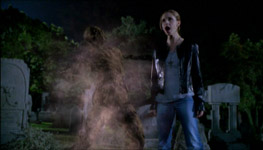 "The Gift", the season five finale, ended with Buffy dead and buried after battling deranged fallen goddess Glory. Dying is kind of old hat for Buffy, and I don't think I'm giving too much away by revealing that the show's title character quickly gets over the whole death thing. Although the ensuing gang of biker demons is corny, I thought her return from the grave in the feature-length "Bargaining" hit all the right notes. Her reappearance is heartbreaking and almost horrifying, and it avoids undermining the events that concluded the previous season. Rather than just toss her back in this mortal coil as if she'd never left, Buffy is distant and depressed, not quite the elated response her friends were expecting to see. The opening of the season offers an evenhanded blend of humor and drama, particularly the early escapades of the Troika. The all-nerd supersquad -- robotics whiz Warren (Adam Busch), clumsy sorceror-lite Jonathan (Danny Strong), and summoner Andrew (Tom Lenk) -- is widely disliked in Buffy circles, but I have to admit to really getting a kick out of them. They added a well-needed dose of geeky comedy to the season, which made the bitter pill of the agony Buffy and friends endure later on easier to swallow. The darker spin the three of them eventually take also resonates more having seen several episodes worth of their giddiness at being supervillains. I also thought the aftermath of Buffy's return, seen in "After Life", "Flooded", and "Life Serial", worked well as she tried to find her place in the world (and her friend's worlds) after being plucked from the afterlife. These episodes also manage to strike that perfect balance between humor and drama, keeping me laughing while still feeling awful for Buffy as she's stuck with a flooded basement she can't afford to repair, later discovering that the only place she fits in with the Scoobies is eviscerating demons. Another early highlight is "Tabula Rasa", where a spell gone awry robs the Scoobies of their memories. The comedy occasionally leaves a bit to be desired, such as a groan-inducing loan shark, but it works more often than not. Of special mention from this chunk of the season, of course, is the musical episode "Once More with Feeling". The version presented here is the original broadcast, a few minutes lengthier than your average Buffy installment. Although the concept of characters in an established drama singing and dancing for an hour screams 'gimmick', it's not a standalone episode, tying in heavily to the previous episodes of the season and setting up some of what would soon follow. The songs are surprisingly good, particularly impressive considering that they were written by someone without much of a musical background. A soundtrack CD is available separately for anyone who's interested.
"The Gift", the season five finale, ended with Buffy dead and buried after battling deranged fallen goddess Glory. Dying is kind of old hat for Buffy, and I don't think I'm giving too much away by revealing that the show's title character quickly gets over the whole death thing. Although the ensuing gang of biker demons is corny, I thought her return from the grave in the feature-length "Bargaining" hit all the right notes. Her reappearance is heartbreaking and almost horrifying, and it avoids undermining the events that concluded the previous season. Rather than just toss her back in this mortal coil as if she'd never left, Buffy is distant and depressed, not quite the elated response her friends were expecting to see. The opening of the season offers an evenhanded blend of humor and drama, particularly the early escapades of the Troika. The all-nerd supersquad -- robotics whiz Warren (Adam Busch), clumsy sorceror-lite Jonathan (Danny Strong), and summoner Andrew (Tom Lenk) -- is widely disliked in Buffy circles, but I have to admit to really getting a kick out of them. They added a well-needed dose of geeky comedy to the season, which made the bitter pill of the agony Buffy and friends endure later on easier to swallow. The darker spin the three of them eventually take also resonates more having seen several episodes worth of their giddiness at being supervillains. I also thought the aftermath of Buffy's return, seen in "After Life", "Flooded", and "Life Serial", worked well as she tried to find her place in the world (and her friend's worlds) after being plucked from the afterlife. These episodes also manage to strike that perfect balance between humor and drama, keeping me laughing while still feeling awful for Buffy as she's stuck with a flooded basement she can't afford to repair, later discovering that the only place she fits in with the Scoobies is eviscerating demons. Another early highlight is "Tabula Rasa", where a spell gone awry robs the Scoobies of their memories. The comedy occasionally leaves a bit to be desired, such as a groan-inducing loan shark, but it works more often than not. Of special mention from this chunk of the season, of course, is the musical episode "Once More with Feeling". The version presented here is the original broadcast, a few minutes lengthier than your average Buffy installment. Although the concept of characters in an established drama singing and dancing for an hour screams 'gimmick', it's not a standalone episode, tying in heavily to the previous episodes of the season and setting up some of what would soon follow. The songs are surprisingly good, particularly impressive considering that they were written by someone without much of a musical background. A soundtrack CD is available separately for anyone who's interested. 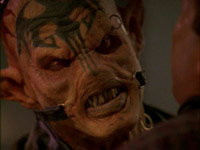 I think a large part of the reason I was once so down on season six is that the mediocre episodes are all bunched up together. It's particularly noticeable with this boxset since there's a grand total of one particularly strong entry across discs three and four. These episodes revolve around Buffy's newfound self-destructive relationship, Willow's dangerous addiction to magic (I promise to complain about this in depth momentarily), Buffy's new gig slinging burgers, Dawn feeling ignored, and the excruciatingly dull and thankfully brief return of Agent Riley Finn to Sunnydale. I recognize that fast food is not a glamorous lifestyle, but the writers treat it like Buffy's whoring herself out on the docks or something. If she can't escape from her problems, at least the invisible Buffy story "Gone" gives her the opportunity to disappear for a while. Might be a good retreat for her, but its shoddy voiceover work and "so long, coppah!" dialogue kinda makes me wish this episode would disappear too. The only episode on the middle two DVDs that I found compelling was "Dead Things", where the Troika, previously seen as just a comic foil, take a considerably darker turn. I also liked chunks of "Smashed", which is a well-written episode even though some of the main plot points rub me the wrong way.
I think a large part of the reason I was once so down on season six is that the mediocre episodes are all bunched up together. It's particularly noticeable with this boxset since there's a grand total of one particularly strong entry across discs three and four. These episodes revolve around Buffy's newfound self-destructive relationship, Willow's dangerous addiction to magic (I promise to complain about this in depth momentarily), Buffy's new gig slinging burgers, Dawn feeling ignored, and the excruciatingly dull and thankfully brief return of Agent Riley Finn to Sunnydale. I recognize that fast food is not a glamorous lifestyle, but the writers treat it like Buffy's whoring herself out on the docks or something. If she can't escape from her problems, at least the invisible Buffy story "Gone" gives her the opportunity to disappear for a while. Might be a good retreat for her, but its shoddy voiceover work and "so long, coppah!" dialogue kinda makes me wish this episode would disappear too. The only episode on the middle two DVDs that I found compelling was "Dead Things", where the Troika, previously seen as just a comic foil, take a considerably darker turn. I also liked chunks of "Smashed", which is a well-written episode even though some of the main plot points rub me the wrong way. After dragging in the middle, the season closes out with a series of strong episodes. "Hell's Bells" features the chaos of a wedding between a human raised in a dysfunctional family and his millennia-old former vengeance demon fiancee, the aftermath of which is explored in "Entropy". One of the season's best is "Normal Again", which questions the reality of what we've seen for the past six seasons, and Buffy's assault on her possibly-delusional friends and family is as chilling as anything seen up to that point on the series. The darkness pervasive throughout much of the season culminates in "Seeing Red", which has two monstrous turning points I not surprisingly can't discuss in an attempt to stay as spoiler-free as possible. Its fatal closing events lead into the three-episode arc that rounds out the season. Similar to Angelus' appearances on both Buffy and Angel, the immeasurably powerful antagonist in these final episodes tear down the main characters, often echoing what's running through my mind as a viewer. As always, I can muster some complaints -- the clumsy misdirection with Spike's storyline, the text of a climactic speech, an energy blast directed towards a god of death -- but I'd still rank it as one of the stronger closings to any of Buffy's seven seasons.
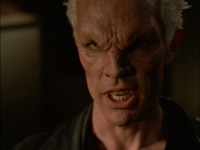 Every season of Buffy up to this point has pitted the Slayer against a "Big Bad", some sort of seemingly indomitable force with the fate of the world invariably lying in the balance. One summary I've frequently read about Buffy's sixth season -- and hey, the title of one of the extras on this DVD set -- is that the Big Bad this time around is life. The biggest struggles are frequently internal to the group -- floundering relationships, destructive addictions, financial woes, kleptomania, responsibility, feeling as if one doesn't belong, facing an uncertain future, dealing with an unbearable present. The foe Buffy and friends face most frequently is themselves; self-loathing is a dominant theme, and the once tightknit group is torn asunder. Nearly every relationship is ripped apart as various episodes focus on marriage, sex, infidelity, and even attempted rape and murder.
Every season of Buffy up to this point has pitted the Slayer against a "Big Bad", some sort of seemingly indomitable force with the fate of the world invariably lying in the balance. One summary I've frequently read about Buffy's sixth season -- and hey, the title of one of the extras on this DVD set -- is that the Big Bad this time around is life. The biggest struggles are frequently internal to the group -- floundering relationships, destructive addictions, financial woes, kleptomania, responsibility, feeling as if one doesn't belong, facing an uncertain future, dealing with an unbearable present. The foe Buffy and friends face most frequently is themselves; self-loathing is a dominant theme, and the once tightknit group is torn asunder. Nearly every relationship is ripped apart as various episodes focus on marriage, sex, infidelity, and even attempted rape and murder. 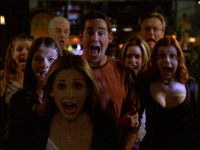 It's welcome to see each of the main characters featured prominently, a juggling act the following season would fail to accomplish, even if not all of the individual arcs work. Dawn is frequently pointed to as one of the weak links in the series, and although she didn't bug me in season five, her incessant fingernails-on-chalkboard whining makes her difficult to relate to here. The most botched arc is Willow's addiction to magic. When the season opens, Willow is shown resorting to sorcery haphazardly, using it to perform even the simplest, most menial tasks. Her thirst for power and disregard for the inevitable consequences begin to separate Willow from her friends. Then, the season takes a U-turn. It's no longer a compulsion to use magic as a crutch that's the crux of Willow's problem. No, if they tossed in a thirteen-year-old Helen Hunt leaping out a window, Buffy would be virtually indistinguishable from an ABC afterschool special. The writers at Mutant Enemy pound the "Magic is a drug!" nail into the ground so overbearingly that it ceases to be a metaphor. Every conceivable cliché is whipped out -- humiliating herself by visiting a dealer in a rundown shack, hallucinating soaring through outer space, vacant-eyed dances, sobbing in the shower, bringing an innocent down with her, cold sweats, gulping down gallons of water...hell, her supplier's name is one letter off from spelling "Crack". Think of a cross between Permanent Midnight and Desperate Lives teeming with the walking undead. Reefer Madness was more restrained than this. In the episode "Gone", Buffy states that candles are like bongs to a witch, and there's a lame gag where a baggie of sage is mistaken for pot. There's no subtlety, and the general concept of a drug-like addiction to magic hadn't been hinted at in five previous seasons of heavy magic use from various characters.
It's welcome to see each of the main characters featured prominently, a juggling act the following season would fail to accomplish, even if not all of the individual arcs work. Dawn is frequently pointed to as one of the weak links in the series, and although she didn't bug me in season five, her incessant fingernails-on-chalkboard whining makes her difficult to relate to here. The most botched arc is Willow's addiction to magic. When the season opens, Willow is shown resorting to sorcery haphazardly, using it to perform even the simplest, most menial tasks. Her thirst for power and disregard for the inevitable consequences begin to separate Willow from her friends. Then, the season takes a U-turn. It's no longer a compulsion to use magic as a crutch that's the crux of Willow's problem. No, if they tossed in a thirteen-year-old Helen Hunt leaping out a window, Buffy would be virtually indistinguishable from an ABC afterschool special. The writers at Mutant Enemy pound the "Magic is a drug!" nail into the ground so overbearingly that it ceases to be a metaphor. Every conceivable cliché is whipped out -- humiliating herself by visiting a dealer in a rundown shack, hallucinating soaring through outer space, vacant-eyed dances, sobbing in the shower, bringing an innocent down with her, cold sweats, gulping down gallons of water...hell, her supplier's name is one letter off from spelling "Crack". Think of a cross between Permanent Midnight and Desperate Lives teeming with the walking undead. Reefer Madness was more restrained than this. In the episode "Gone", Buffy states that candles are like bongs to a witch, and there's a lame gag where a baggie of sage is mistaken for pot. There's no subtlety, and the general concept of a drug-like addiction to magic hadn't been hinted at in five previous seasons of heavy magic use from various characters. Fans of the show who prefer to pretend the UPN era of Buffy never took place should still consider picking up season six as a purchase or at least a rental. The season played much better for me the second time through; I think it helps to go in already having seen some of its twists and turns, not to mention not having to wade through UPN's staggered broadcast schedule. The plotting isn't as tight as I would've liked, the season drags pretty heavily in the middle, the dialogue isn't up to what I consider to be Mutant Enemy's usual standards, and I'm convinced the season would've benefitted with a few rays of sunshine to break through all the darkness. Still, I think other fans who shared my initial disappointment may look at season six of Buffy the Vampire Slayer differently with another viewing.
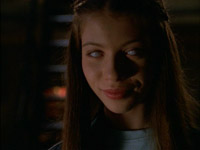 Video: I've prattled on about Buffy's aspect ratio twice before, and I'm not going to bother rehashing those arguments here. These episodes, with one exception, are presented full-frame, the way they were intended to be seen. This set includes the one episode of the series that was shot specifically for widescreen, the letterboxed "Once More with Feeling". Buffy fans with 16x9 displays may be disappointed to hear that this episode isn't presented in anamorphic widescreen. It may also be worth noting that the image in "Once More with Feeling" is heavily windowboxed to help compensate for overscan. Steering away from aspect ratios for a moment, the sixth season of Buffy is the best looking to date. It's sharp and detailed, offering a wide variety of colors when given the opportunity. The visuals can get as dark literally as the season is figuratively, and black levels and shadow detail all hold up even in the most dimly-lit sequences. There are, as expected, no print flaws and no particularly noticeable edge haloing. Some film grain is present, but not to any greater extent than I'd expect from a television series, and it's compressed in such a way that the grain doesn't devolve into a big messy block of digital artifacts. "Once More with Feeling" is particularly impressive, and despite not benefitting from 16x9-enhancement, it's indistinguishable from a feature film. The visual end of this set is really nicely done, and it's a monstrous leap up from what I've been seeing on cable.
Video: I've prattled on about Buffy's aspect ratio twice before, and I'm not going to bother rehashing those arguments here. These episodes, with one exception, are presented full-frame, the way they were intended to be seen. This set includes the one episode of the series that was shot specifically for widescreen, the letterboxed "Once More with Feeling". Buffy fans with 16x9 displays may be disappointed to hear that this episode isn't presented in anamorphic widescreen. It may also be worth noting that the image in "Once More with Feeling" is heavily windowboxed to help compensate for overscan. Steering away from aspect ratios for a moment, the sixth season of Buffy is the best looking to date. It's sharp and detailed, offering a wide variety of colors when given the opportunity. The visuals can get as dark literally as the season is figuratively, and black levels and shadow detail all hold up even in the most dimly-lit sequences. There are, as expected, no print flaws and no particularly noticeable edge haloing. Some film grain is present, but not to any greater extent than I'd expect from a television series, and it's compressed in such a way that the grain doesn't devolve into a big messy block of digital artifacts. "Once More with Feeling" is particularly impressive, and despite not benefitting from 16x9-enhancement, it's indistinguishable from a feature film. The visual end of this set is really nicely done, and it's a monstrous leap up from what I've been seeing on cable. Audio: The sixth season of Buffy is accompanied by a set of Dolby Digital 2.0 surround tracks in English, French, and Spanish, each encoded at a bitrate of 192KBps. The 'surround' component is light, largely just reinforcing the score and various bits of music tossed in. Aside from established acts like Bush, Sarah McLachlan, and Michelle Branch, this season continues Buffy's tradition of shining the spotlight on lesser-known groups, this time including the likes of Man of the Year and Halo Friendlies. Activity in the lower frequencies is decent but unremarkable. Dialogue is one of the hallmarks of the series, and it generally comes through, marred by some infrequent flickers of distortion. The overall quality is pretty typical for a TV-on-DVD release. Subtitles have been provided in English and Spanish, and all of its episodes are closed captioned.
Supplements: Each of the six discs in this set has at least something extra tacked on, totalling around nine and a half hours. Uninitiated viewers should hold off on viewing the extras until finishing the season in its entirety because of the sheer number of spoiler-riddled discussions. The first disc offers a commentary for "Bargaining" with writers David Fury and the touching, incredibly maudlin Marti Noxon. Despite commenting on a two-part episode, there really aren't that many lengthy gaps scattered throughout. They cover a lot of ground in this hour and a half, including Emma Caulfield's gradual progression to becoming Sarah Michelle Gellar Mark II, the meaningless of the numbers on their wardrobe, George Lucas' jaunt to the Buffy set, the proper pronunciation of the name of composer Thomas Wanker, unsatisfying plot points, an originally more graphic sacrifice scene, Joss requesting that Marti avoid watching the Buffy movie, neatly combed post-resurrection hair, an uninviting premiere for new viewers, crazy scaffolding...okay, I think that list is long enough.
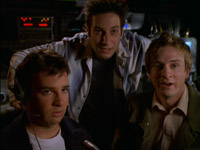 "Once More with Feeling" is lavished with the special edition treatment on disc two. First up is a half-hour peek behind the scenes courtesy of David Fury. It compiles footage snapped both during and between takes, compares that raw material to the polished product, and takes viewers into production meetings. We get a glimpse of the choreography, the actors belting it out in the recording studio, and the application of some of the make-up effects. It's a candid look at what goes into making an episode, and this is not only the best extra on this season set of Buffy, it's perhaps the best of any of the six DVD boxsets to date. Singalong versions of "I've Got a Theory / Bunnies / We're Together", "I'll Never Tell", and "Walk Through the Fire" are also provided. It's footage from the episode with the lyrics on-screen, not karaoke in the sense of having the vocals removed. Joss Whedon's commentaries are always a highlight of these DVD collections, and this being such a key episode of the series, he contributes one for "Once More with Feeling" as well. He hardly stops to take a breath for the duration. Joss tackles every conceivable angle, from the intentions of particular songs, incorporating the cast's individual talents into the tunes and dance numbers, suspension of disbelief, the role of Disney animation as a source of inspiration, learning to play guitar specifically for this musical, and trying to avoid making the episode seem like an event. Joss' rapid-fire wit carries through with this commentary as well. An Easter Egg is hidden on the Language Selection menu for the episode, by the way. Selecting a hidden symbol to the left of the "Subtitles" label reveals some footage from a signing of the soundtrack.
"Once More with Feeling" is lavished with the special edition treatment on disc two. First up is a half-hour peek behind the scenes courtesy of David Fury. It compiles footage snapped both during and between takes, compares that raw material to the polished product, and takes viewers into production meetings. We get a glimpse of the choreography, the actors belting it out in the recording studio, and the application of some of the make-up effects. It's a candid look at what goes into making an episode, and this is not only the best extra on this season set of Buffy, it's perhaps the best of any of the six DVD boxsets to date. Singalong versions of "I've Got a Theory / Bunnies / We're Together", "I'll Never Tell", and "Walk Through the Fire" are also provided. It's footage from the episode with the lyrics on-screen, not karaoke in the sense of having the vocals removed. Joss Whedon's commentaries are always a highlight of these DVD collections, and this being such a key episode of the series, he contributes one for "Once More with Feeling" as well. He hardly stops to take a breath for the duration. Joss tackles every conceivable angle, from the intentions of particular songs, incorporating the cast's individual talents into the tunes and dance numbers, suspension of disbelief, the role of Disney animation as a source of inspiration, learning to play guitar specifically for this musical, and trying to avoid making the episode seem like an event. Joss' rapid-fire wit carries through with this commentary as well. An Easter Egg is hidden on the Language Selection menu for the episode, by the way. Selecting a hidden symbol to the left of the "Subtitles" label reveals some footage from a signing of the soundtrack. This third disc includes another of the most entertaining and informative extras on this set, an hour-long panel discussion at the Academy of Television Arts and Sciences. It was taped on June 18th, 2002 with creator Joss Whedon, director of photography Raymond Stella, production designer Carey Meyer, show runner Marti Noxon, and cast members Nicholas Brendon, Alyson Hannigan, James Marsters, and Michelle Trachtenberg in attendance. The discussion revolves almost entirely around season six and its aftermath, focusing heavily on the musical, set design, taking characters to such a dark place, the more lurid aspects of the season, taking a more literal approach to storytelling rather than relying so much on metaphors, Joss' work ethic, and the challenges of shooting a show like Buffy. Also on this disc is a commentary by writer Drew Z. Greenberg for "Smashed", the first episode where he had the opportunity to see his name onscreen in the familiar Buffy font. It's a good track, including notes about the headaches associated with using exotic languages for spells and striving for proper 1979 Boba Fett accuracy.
The "Buffy Goes to Work" featurette on disc four runs just over five minutes in length, featuring Jane Espenson, David Solomon, David Fury, Drew Z. Greenberg, Michelle Trachtenberg, Adam Busch, Christopher Buchanan, Joss Whedon, Steven S. DeKnight, Alyson Hannigan, and Rebecca Rand Kirshner reminiscing about their first jobs and noting what their dream gigs would be.
Disc five includes a pair of commentaries. The first is for "Hell's Bells", and Emma Caulfield was originally going to contribute to the track. Instead, she left director David Solomon and writer Rebecca Rand Kirshner to take it alone. Neither have all that much to say other than brief, scattered little quips. A better writer/director pairing quickly follows with "Normal Again", featuring commentary by Rick Rosenthal (Halloween II) and Diego Gutierrez. It's a little dry and slow-moving at first, but it gets better as it goes along. As this was a favorite episode of mine, I appreciated the commentary, particularly their discussion about the ambiguity of the varying realities "Normal Again" presents. The performances and the structure of the episode are also frequent topics of discussion. Though not labeled as an extra, disc five also includes a callsheet for "Normal Again" on the DVD-ROM portion of the disc.
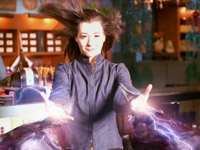 The bulk of the extras are located on the sixth and final disc. "Life Is the Big Bad" is a half-hour overview that takes a different approach to the material than those on previous Buffy boxes. Rather than just go episode by episode with their recaps, the featurette examines individual characters and what happens to them throughout the course of the season. The participants include most of the writing staff and a handful of actors -- Joss Whedon, David Fury, Jane Espenson, Doug Petrie, David Solomon, Steven S. DeKnight, Drew Z. Greenberg, Rebecca Rand Kirshner, Michelle Trachtenberg, Alyson Hannigan, and Adam Busch. Another lengthy collection of interviews is the 43 minute "Buffy the Vampire Slayer - Television with a Bite", a TVography that aired on A&E. The overview covers Buffy's origins as a movie, its incarnation as a TV show that the major networks resisted, its rise to popularity and critical reception, crafting a spinoff, and the business of network leaping. Many key episodes and events are touched upon, with special emphasis paid to "Earshot", "The Body", and "Once More with Feeling". Most of the principals are interviewed, including Joss Whedon, Gail Berman, Anthony Stewart Head, Michelle Trachtenberg, Alyson Hannigan, David Boreanaz, Marti Noxon, James Marsters, Emma Caulfield, and...wow, that's rare...Sarah Michelle Gellar. A fair amount of behind the scenes footage, even some glimpses of storyboards, are also provided. James A. Contner and writer David Fury chime in with a commentary for the season finale "Grave". Some of my favorite bits in their track centered around what didn't make it into the final episode, including some intended dragon slayage (which made me smirk, considering one of the last lines of dialogue of the Buffyverse from a couple days ago) and an aborted sewer brawl. They also speak at length about how some of the effects were accomplished, and there are even some comments about Sarah Michelle Gellar's questionable on-cue laughs. It's also revealed that although Joss didn't write or direct the season finale, a first for Buffy, he did pen the climactic speech. The last of the set-top-accessible extras is an outtake reel that captures a couple minutes of flubbed lines and uncontrollable bursts of laughter. Readers with a DVD-ROM can also tap into Willow's Demon Database, which lists the nasties from the first six seasons of the series.
The bulk of the extras are located on the sixth and final disc. "Life Is the Big Bad" is a half-hour overview that takes a different approach to the material than those on previous Buffy boxes. Rather than just go episode by episode with their recaps, the featurette examines individual characters and what happens to them throughout the course of the season. The participants include most of the writing staff and a handful of actors -- Joss Whedon, David Fury, Jane Espenson, Doug Petrie, David Solomon, Steven S. DeKnight, Drew Z. Greenberg, Rebecca Rand Kirshner, Michelle Trachtenberg, Alyson Hannigan, and Adam Busch. Another lengthy collection of interviews is the 43 minute "Buffy the Vampire Slayer - Television with a Bite", a TVography that aired on A&E. The overview covers Buffy's origins as a movie, its incarnation as a TV show that the major networks resisted, its rise to popularity and critical reception, crafting a spinoff, and the business of network leaping. Many key episodes and events are touched upon, with special emphasis paid to "Earshot", "The Body", and "Once More with Feeling". Most of the principals are interviewed, including Joss Whedon, Gail Berman, Anthony Stewart Head, Michelle Trachtenberg, Alyson Hannigan, David Boreanaz, Marti Noxon, James Marsters, Emma Caulfield, and...wow, that's rare...Sarah Michelle Gellar. A fair amount of behind the scenes footage, even some glimpses of storyboards, are also provided. James A. Contner and writer David Fury chime in with a commentary for the season finale "Grave". Some of my favorite bits in their track centered around what didn't make it into the final episode, including some intended dragon slayage (which made me smirk, considering one of the last lines of dialogue of the Buffyverse from a couple days ago) and an aborted sewer brawl. They also speak at length about how some of the effects were accomplished, and there are even some comments about Sarah Michelle Gellar's questionable on-cue laughs. It's also revealed that although Joss didn't write or direct the season finale, a first for Buffy, he did pen the climactic speech. The last of the set-top-accessible extras is an outtake reel that captures a couple minutes of flubbed lines and uncontrollable bursts of laughter. Readers with a DVD-ROM can also tap into Willow's Demon Database, which lists the nasties from the first six seasons of the series. As has been the case with the other box sets up to this point, the "Previously on..."s are still missing in action domestically. Each disc features a set of animated 16x9-enhanced menus, and the traditional length episodes are divided into somewhere in the neighborhood of fifteen chapters. A set of brief liner notes provides synopses for the episodes on each disc, and another insert notes the seventh and final season of Buffy will be released on DVD this October.
Conclusion: Despite detesting it when it first aired, I found myself with a great appreciation of the penultimate season of Buffy the Vampire Slayer with a second viewing. This being their tenth Mutant Enemy box set, Fox Home Video has a pretty firm grasp on what Joss Whedon's fans want on their DVDs, and this set includes a solid assortment of extras alongside the expected improvements in video quality. Though I consider this season to be a few steps down from the series' creative pinnacle, this collection of Buffy the Vampire Slayer's sixth season still comes recommended.
Related Reviews: DVD Talk also has reviews for other Buffy DVDs, box sets of its spinoff Angel, and Whedon's criminally shortlived Firefly.
|
| Popular Reviews |
| Sponsored Links |
|
|
| Sponsored Links |
|
|
| Release List | Reviews | Shop | Newsletter | Forum | DVD Giveaways | Blu-Ray | Advertise |
|
Copyright 2024 DVDTalk.com All Rights Reserved. Legal Info, Privacy Policy, Terms of Use,
Manage Preferences,
Your Privacy Choices | |||||||












